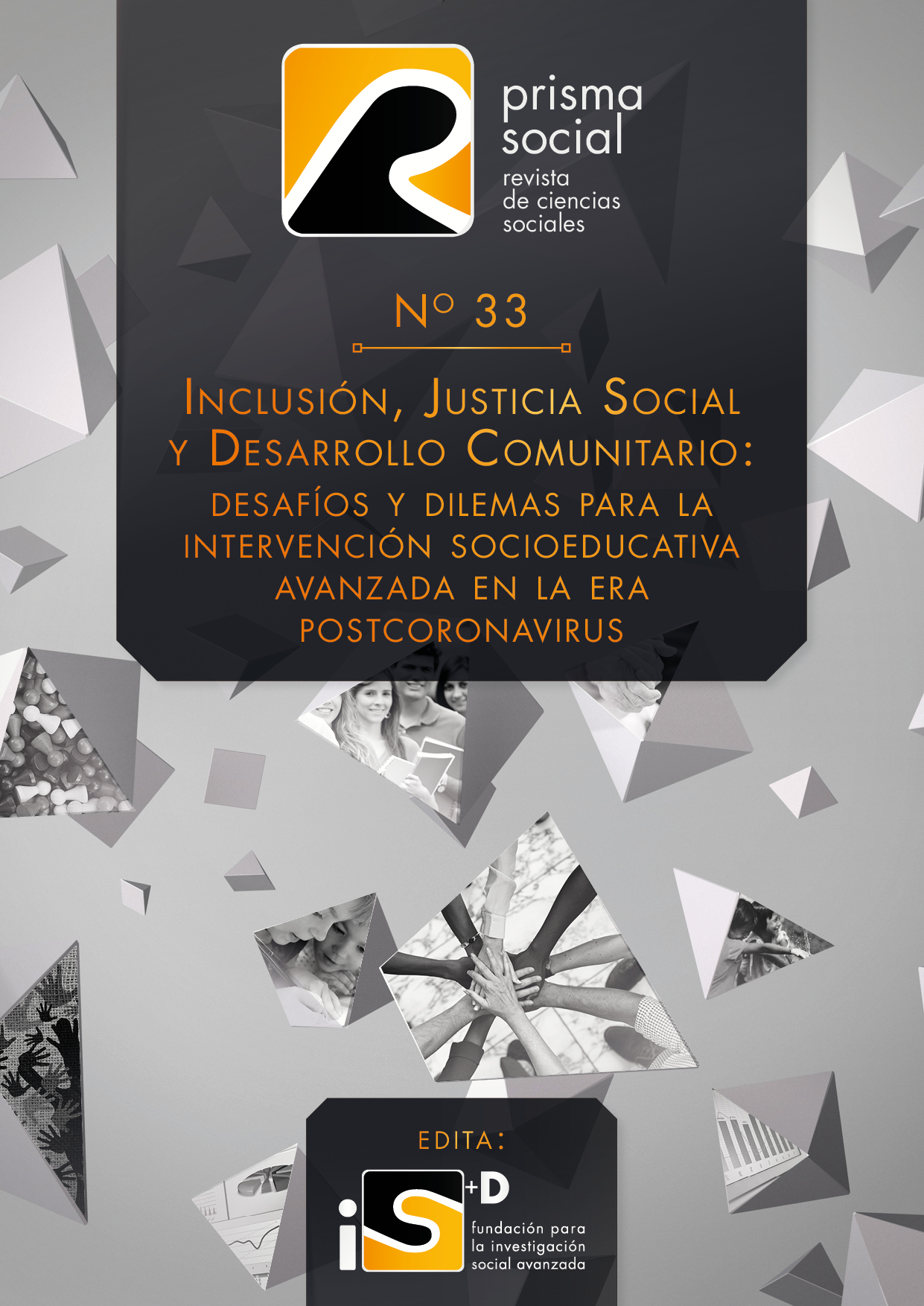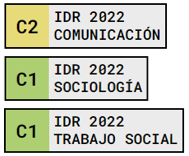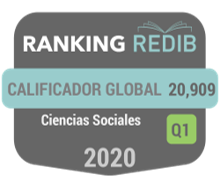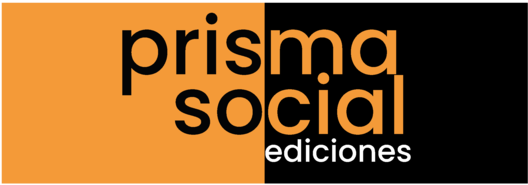Influence of the context in the self-perception of social risk by the students of Compulsory Secondary Education
The case of the Asturian Coal Mining Area
Keywords:
Context; social risk; education system; adolescence; self-perception; vulnerabilityAbstract
Adolescence, the path from childhood to youth, fits perfectly with the etymological origin of the term "risk", which refers to the dangers and vulnerability present in a journey. The most intense moment of vital change in all areas and dimensions coincides with Compulsory Secondary Education. Despite this, the Education System does not have a consensual or defined conceptualisation of social risk for its pupils. In order to study this reality, we used the SENA measurement instrument, which includes scales of problems, vulnerability and personal resources, and we looked at the needs felt or perceived by the students themselves, through self-reports. In order to overcome the difficulty of collecting information at this age, we involved the educational community and the pupils themselves, and had specially trained interviewers.
In order to check the influence of the context on self-perception of risk, we compared the results obtained in schools in the Asturian mining area, where the socio-occupational situation is of serious difficulty and deterioration, with the responses from the rest of Asturias, obtaining results that demonstrated the influence of this variable.
Downloads
References
Abiétar-López, M., Navas-Saurin, A., Maruenda-Fluixá, F. y Salvà-Mut, F. (2017). Expectativas de los PTSC en la Comunidad de Madrid. La construcción de subjetividades en itinerarios de fracaso escolar. Itinerarios de inserción sociolaboral para adolescentes en riesgo. Pychosocial Intervention, 26, 39-45. DOI: 10.1016/j.psi.2016.07.002
Adame, T. y Salvà, F. (2010). Abandono escolar prematuro y transición a la vida activa en una economía turística: el caso de Baleares. Revista de Educación, 35, 185-210.
Alfonso, J. P., Huedo-Medina, T. B. y Espada, J. P. (2009). Factores de riesgo predictores del patrón de consumo de drogas durante la adolescencia. Anales de Psicología, 25(2), 330-338.
Álvarez-García, D., Dobarro, A., Álvarez, L., Núñez, J. C. y Rodríguez, C. (2014). La violencia escolar en los centros de educación secundaria de Asturias desde la perspectiva del alumnado. Educación XX1, 17(2), 337-360. DOI: 10.5944/educxx1.17.2.11494
Arce, R., Fariña, F., Seijo, D., Novo, M. y Vázquez, M. J. (2005). Contrastando los factores de riesgo y protectores del comportamiento inadaptado en menores: Implicaciones para la prevención. En: Centro de Investigación y Documentación Educativa (Ed.) (2004). Premios nacionales de investigación educativa 2004, 17-50. Madrid: Ministerio de Educación y Ciencia. Recuperado de http://www.redalyc.org/ articulo.oa?id=344054646009
Beidel D.C. y Randall J. (1994). Social phobia. En: T.H. Ollendick, N.J. King y W. Yule (Eds.): International handbook of phobic and anxiety disorders in children and adolescents. New York: Plenum Press.
Blakemore, S. J. y Mills, K. L. (2014). Is adolescence a sensitive period for sociocultural processing? Annu. Rev. Psychol. 65, 187–207. DOI: 10.1146/annurevpsych- 010213-115202
Blakemore S. J. y Robbins T. W. (2012). Decision-making in the adolescent brain. Nature Neuroscience, 15 (9), 1184-1191. DOI: 10.1038/nn.3177
Caicedo, B. y Berbesi, D. (2015) Salud autorreferida: influencia de la pobreza y la desigualdad del área de residencia. Gaceta Sanitaria, Volume 29, Issue 2, 2015, Pages 97-104, https://doi.org/10.1016/j.gaceta.2014.11.007 (http://www.sciencedirect.com/science/article/pii/S0213911114002829
Camberos, M. y Bracamontes, J. (2015). Las crisis económicas y sus efectos en el mercado de trabajo, en la desigualdad y en la pobreza de México. Contaduría y Administración,Volume 60, Supplement 2,2015, Pages 219-249, https://doi.org/10.1016/j.cya.2015.05.003. (http://www.sciencedirect.com/science/article/pii/S0186104215000042)
Carballo, J. L., García, O., Secades, R., Fernández, J. R., García, E., Errasti, J. M. y Al- Halabi, S. (2004). Construcción y validación de un cuestionario de factores de riesgo interpersonales para el consumo de drogas en la adolescencia. Psicothema, 16(4), 674-679.
Cerezo, F. (2009). Bullying: Análisis de la situación en las aulas españolas. International Journal of Psychology and Psychological Therapy, 9(3), 383-394.
Cerezo, F. Méndez, I. y Ato, M. (2013). Moderating role of family and friends’ factors between dissocial behavior and consumption in adolescents. International Journal of Clinical and Health Psychology, 13(3), 171-180. DOI: 10.1016/S1697 2600(13)70021-8
Cordero, J. M., Manchón, C. y Simancas, R. (2014). La repetición de curso y sus factores condicionantes en España. Revista de Educación, 365, 2-37.
Corominas, J. (1980). Diccionario crítico etimológico castellano e hispánico, Madrid: Gredos.
Crone, E. A. y Dahl, R. E. (2012). Understanding adolescence as a period of socialaffective engagment and goal flexibility. Nat. Rev. Neurosci. 13, 636–650. DOI: 10.1038/ nrn3313
Fernández Cortés, I. y Fernández Villanueva, M. C. (2011) La intervención social en el contexto educativo: funciones y Revista Iberoamericana de Educación, 56(4), 1-11.
Fernández-Pinto, I., Santamaría, P., Sánchez-Sánchez, F., Carrasco, M. A. y del Barrio, V. (2015). SENA. Sistema de Evaluación de Niños y Adolescentes. Manual de aplicación, corrección e interpretación. Madrid: TEA Ediciones.
Garaigordobil, M. y Oñederra, J. A. (2010). La violencia entre iguales. Revisión teórica y estrategias de intervención. Madrid: Pirámide.
García Acosta, V. (2005). El riesgo como construcción social y la construcción social de riesgos. Desacatos. Revista de Ciencias Sociales, 19, 11-24.
Gómez, J. A., Luengo-Martín, Á., Romero-Triñanes, E., Villar-Torres, P. y Sobral- Fernández, J. (2006). Estrategias de afrontamiento en el inicio de la adolescencia y su relación con el consumo de drogas y la conducta problemática. International Journal of Clinical and Health Psychology, 6(3), 581-597.
Guyer, A. E., Silk, J. S. y Nelson, E. E. (2016). The neurobiology of the emotional adolescent: From the inside out. Neurosci. Biobehav. Rev., 70, 74-85. DOI: 10.1016/ j.neubiorev.2016.07.037
Herd, T., Kim-Spoon. J. (2021). A Systematic Review of Associations Between Adverse Peer Experiences and Emotion Regulation in Adolescence. Clin. Child. Fam. Psychol. Rev., 24(1):141-163. DOI: 10.1007/s10567-020-00337-x.
Holzmann, R. y Jørgensen, S. (2003) Manejo social del riesgo: un nuevo marco conceptual para la protección social y más allá Social. Rev. Fac. Nac. Salud Pública, 21(1), 73-106.
Hymel, S. y Swearer S. M. (2015). Four decades of Research on School Bullying. An Introduction. American Psychological Association, 70(4), 293–299. DOI: 10.1037/ a0038928
Instituto Nacional de Evaluación Educativa (2016). Sistema Estatal de Indicadores de la Educación. Madrid: Secretaría General Técnica. Ministerio de Ecuación, Cultura y Deporte. Recuperado de http://educalab.es/document/10180/15845/2016SistemaestataldeindicadoresdelaEducaci%C3%B3n.pdf/89e4c98edc7e-41d7-8084-25329329bab6.
Jessor, R., Turbin, M. S., Costa, F. M., Dong, Q., Zhang H. y Wang, Z. (2003). Adolescent problem behavior in China and United States: A cross national study of psychosocial protective factors. Journal of Research on Adolescence, 13, 329-360. DOI: 10.1111/1532-7795.1303004
Kilford, E.J., Garrett, E. y Blakemore, S-J. (2016). The Development of Social Cognition in Adolescence: An Integrated Perspective. Neurosci. Biobehav. Rev., 70, 106-120. DOI: 10.1016/j.neubiorev.2016.08.016
Larrañaga, O. (2010) Las nuevas políticas de protección social en perspectiva histórica. Naciones Unidas. Documento de Trabajo 4. En: Larrañaga, O. y Contreras, D. (2010) (Ed.), Las nuevas políticas de protección social. Santiago de Chile. Recuperado de http://ministeriodesarrollosocial.gob.cl/btca/txtcompleto/Larrañaga_nvaspolitprotecsocial.pdf
Lozano Díaz, A. (2009). Factores personales, familiares y académicos que afectan al fracaso escolar en Educación Secundaria. Revista Electrónica de Investigación Psicoeducativa y Psicopedagógica, 1(1), 43-66.
Martínez González, R. A. y Álvarez Blanco, L. (2005). Fracaso y abandono escolar en Educación Secundaria Obligatoria: implicación de la familia y los centros escolares. Aula Abierta, 85, 127-146.
Meeus, W. (2011). The study of adolescent identity formation 2000-2010: a review of longitudinal research. J. Res. Adolesc., 21, 75–94. DOI: 10.1111/j. 1532-7795.2010.00716.x
Méndez, I. y Cerezo, F. (2018) La repetición escolar en educación secundaria y factores de riesgo asociados. Educación XX1, 21(1), 41-62. DOI: 10.5944/educxx1.20172
Mills, K. L., Goddings A. L., Clasen L. S., Giedd J. N. y Blakemore S. J. (2014). The developmental mismatch in structural brain maturation during adolescence. Developmental Neuroscience, 36(3-4), 147-160. DOI: 10.1159/000362328
Moliner, M. (1983). Diccionario del uso del español, Madrid: Gredos.
Monreal, P. (1996). Antropología y pobreza urbana. Madrid: Los Libros de Catarata.Adela García, Universidad de Barcelona.
Navarro, E., Moral, J.C., A. y Beitia, M.D. (2012). Desarrollo infantil y adolescente: Trastornos mentales más frecuentes en función de la edad y el género. Psicothema, 24(3), 377-383.
Navarro, J. J. y Martínez-Muñoz, E. V. (2014). Trabajo Social Comunitario y Formación en Centros de Trabajo: una propuesta para la inserción de adolescentes problematizados desde la Educación Formal. Comunitania, Revista Internacional de Trabajo Social y Ciencias Sociales, 8, 87-104.
Nelson, E.E., Jarcho, J.M. y Guyer, A.E. (2016). Social re-orientation and brain development: an expanded and updated view. Dev. Cogn. Neurosci., 17, 118–127. DOI: 10.1016/j.dcn.2015.12.008
Pantoja, L. y Añaños, F. (2010) Actuaciones socioeducativas con menores vulnerables, en riesgo, relacionados con las drogas. Reflexiones críticas. Sips - Revista Interuniversitaria de Pedagogía Social, 17, 109-122.
Prattley, J., Buffel, T., Marshall, A. y Nazroo, J. (2020) Area effects on the level and development of social exclusion in later life, Social Science & Medicine, Volume 246, 2020, 112722, https://doi.org/10.1016/j.socscimed.2019.112722. (http://www.sciencedirect.com/science/article/pii/S0277953619307178)
Quintero J. (2018). El cerebro adolescescente. Barcelona: Bonalletra Alcompas.
Real Academia Española (2001), Diccionario de la lengua española (22 Ed), Madrid, España: Autor.
Rivas Fernández, A., Iglesias Pintado, A., Conejo Jiménez, N. M. y Arias Pérez, J. L. (2019) Necesidad de conceptualizar el "riesgo social" en el Sistema Educativo, Revista Prisma Social, 25. Fecha prevista de publicación: abril de 2019
Ruiz-Juan, F. y Ruiz-Risueño, J. (2011). Variables predictoras de consumo de alcohol entre adolescentes españoles. Anales de Psicología, 27(2), 350-359.
Somerville, L. H., Jones, R.M. y Casey, B.J. (2010). A time of change: behavioral and neural correlates of adolescent sensitivity to appetitive and aversive environmental cues. Brain Cogn., 72, 124–133. DOI: 10.1016/j.bandc.2009.07.003
Steinberg, L. (2005). Cognitive and affective development in adolescence. Trends Cogn. Sci., 9 (2), 69–74. DOI: 10.1016/j.tics.2004.12.005
Steinberg, L. (2008). A social neuroscience perspective on adolescent risk-taking. Dev. Rev., 28, 78–106. DOI: 10.1016/j.dr.2007.08.002
Subramanian SV, Kubzansky L, Berkman L, et al. (2006). Neighborhood effects on theself-rated health of elders: uncovering the relative importance of structural andservice-related neighborhood environments. J Gerontol B Psychol Sci Soc Sci.2006;61:S153–60.
Thompson, J.L. y Nelson, A.J. (2011). Middle childhood and modern human origins. Human Nat., 22(3), 249–280. DOI: 10.1007/s12110-011-9119-3
Wacquant, L. (2001). Parias urbanos: marginalidad en la ciudad a comienzos del milenio. Buenos Aires: Manantia
Downloads
Published
How to Cite
Issue
Section
License
Those authors who publish in this journal accept the following terms:
-
Authors retain copyright.
-
Authors transfer to the journal the right of first publication. The journal also owns the publishing rights.
-
All published contents are governed by an Attribution-NoDerivatives 4.0 International License.
Access the informative version and legal text of the license. By virtue of this, third parties are allowed to use what is published as long as they mention the authorship of the work and the first publication in this journal. If you transform the material, you may not distribute the modified work. -
Authors may make other independent and additional contractual arrangements for non-exclusive distribution of the version of the article published in this journal (e.g., inclusion in an institutional repository or publication in a book) as long as they clearly indicate that the work was first published in this journal.
- Authors are allowed and recommended to publish their work on the Internet (for example on institutional and personal websites), following the publication of, and referencing the journal, as this could lead to constructive exchanges and a more extensive and quick circulation of published works (see The Effect of Open Access).


















